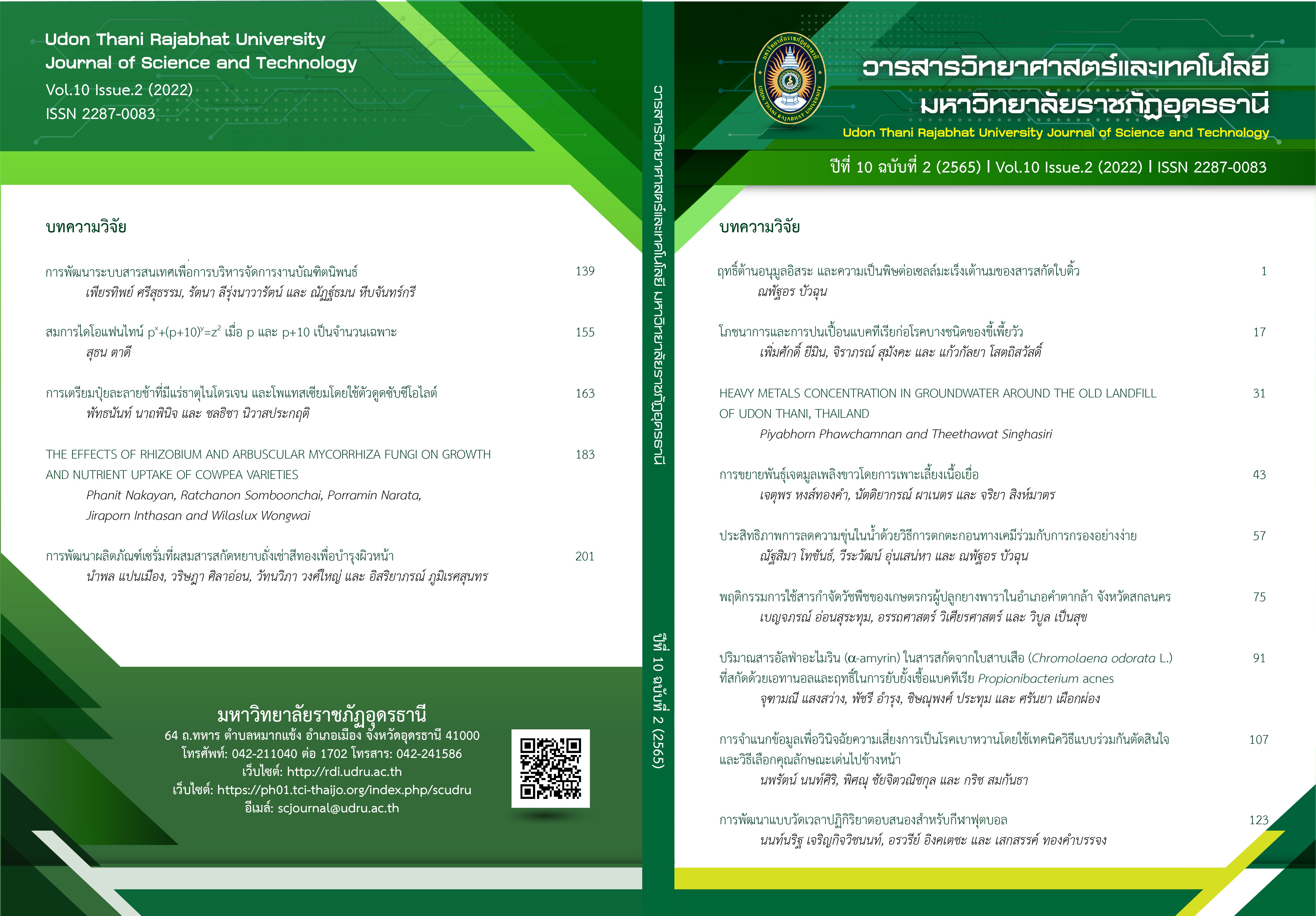IN VITRO PROPAGATION OF PLUMBAGO ZEYLANICA L.
Main Article Content
Abstract
This study aimed to investigate in vitro propagation of Plumbago zeylanica L. The axillary buds were surface sterilized with various concentrations of sodium hypochlorite (NaOCl) for 10 and 15 minutes. The result showed that the suitable concentration and duration of NaOCl were 1.24% and 10 minutes which presented the highest survival percentage of axillary buds 92%. The sterilized axillary buds were cultured on MS medium supplemented with 0-4 mg/l BA for shoots induction. After 8 weeks of culture, the result of shoot induction using 4 mg/l BA indicated that the highest shoot was 3.28 shoot/ explant, the average of shoot height and leaves were 61.86 mm and 8.57 leaves/ shoot, respectively. The shoots were transferred to MS medium supplemented with 0-2 mg/l NAA for roots induction at 4 weeks. It was found that the highest of root induction was observed from the medium supplemented with 2 mg/l NAA. The maximum number of roots and the highest of roots length were 11.75 roots per shoot and 31.50 mm., respectively.
Article Details
References
กัญญาภรณ์ พิพิธแสงจันทร์. (2561). เทคโนโลยีการอนุรักษ์เชื้อพันธุกรรมพืชในธนาคารเชื้อพันธุ์พืชกรมวิชาการเกษตร. รายงานโครงการวิจัย, กรมวิชาการเกษตร.
เกศินี ศรีปฐมกุล, อารยา อาจเจริญ เทียนหอม และ ทัศนัย จารุวัฒนพันธ์. (2563). การขยาย พันธุ์ในสภาพปลอดเชื้อหญ้าพันเกลียว (Ceropegia thailandica Meve) พืชใกล้สูญพันธุ์อย่างยิ่งในประเทศไทย. The Journal of Science and Technology, 9(1), 77-89. Doi:10.14456/tjst.2020.7.
จันทร์เพ็ญ ใจซื่อ, สุรพล ฐิติธนากุล, สรายุทธ อ่อนสนิท และ เยาวพรรณ สนธิกุล. (2562). เทคนิคการฟอกฆ่าเชื้อชิ้นส่วนต้นหม้อข้าวหม้อแกงลิงจากธรรมชาติเพื่อการเพาะเลี้ยงเนื้อเยื่อ. แก่นเกษตร 47(ฉบับพิเศษ 1), 1515-1520.
นงนุช เลาหะวิสุทธิ์, อัจฉรี เรืองเดช, สมเกียรติ สีสนอง และ สมชาย หวังวิบูลย์กิจ. (2560). ผลของสารฟอกฆ่าเชื้อและสารควบคุมการเจริญเติบโตในการเพาะเลี้ยงเนื้อเยื่อพรรณไม้น้ำบูเซป Bucephalandra sp. วารสารเกษตรพระจอมเกล้า, 35(2), 95-103.
บุญยืน กิจวิจารณ์. (2547). เทคโนโลยีเบื้องต้นการเพาะเลี้ยงเนื้อเยื่อพืชเพื่อพัฒนาพืช. ขอนแก่น: ภาควิชาชีววิทยา, มหาวิทยาลัยขอนแก่น.
ประศาสตร์ เกื้อมณี. (2538). เทคนิคการเพาะเลี้ยงเนื้อเยื่อพืช. กรุงเทพฯ: สำนักพิมพ์โอเดียนสโตร์.
พัชรียา บุญกอแก้ว. (2560). สารควบคุมการเจริญเติบโตในพืชสวน. กรุงเทพฯ: บริษัทสหมิตร พริ้นติ้งแอนด์พับลิชิ่ง จำกัด.
เพ็ญนภา ทรัพย์เจริญ. (2542). การแพทย์แผนไทยสายใยแห่งชีวิตและวัฒนธรรม เล่มที่ 2. กรุงเทพฯ: โรงพิมพ์องค์การสงเคราะห์ทหารผ่านศึก.
ภพเก้า พุทธรักษ์, วารุต อยู่คง และ มณฑล สงวนเสริมศรี. (2554). การขยายพันธุ์ว่านสี่ทิศโดยการเพาะเลี้ยงเนื้อเยื่อในสภาพปลอดเชื้อ. วาสารนเรศวรพะเยา, 4(3), 3-8.
รังสฤษฏ์ กาวีต๊ะ. (2540). การเพาะเลี้ยงเนื้อเยื่อพืช : หลักการและเทคนิค. กรุงเทพฯ: สำนักพิมพ์มหาวิทยาเกษตรศาสตร์.
วราภรณ์ ภูตะลุน. (2551). การเพาะเลี้ยงเนื้อเยื่อพืชสมุนไพร : แนวทางการศึกษาเพื่อผลิตสารทุติยภูมิที่มีฤทธิ์ทางเภสัชวิทยา. ขอนแก่น: บริษัทขอนแก่นพิมพ์พัฒนา จำกัด.
ศิวพงศ์ จำรัสพันธุ์. (2546). การเพาะเลี้ยงเนื้อเยื่อพืช. คณะวิทยาศาสตร์และเทคโนโลยี สถาบันราชภัฏอุดรธานี, อุดรธานี.
Aziz, M. H., Dreckschmidt, N. E., & Verma, A. K. (2008). Plumbagin, a medicinal plant-derived naphthoquione, is a novel inhibitor of the growth and invasion of hormone-refractory prostate cancer. Cancer Research, 68, 9024-9032.
Ceasar, S. A., Ayyanar, M., & Ignacimuthu, S. (2013). An Improved Micropropagation Protocol for Plumbago zeylanica L. An Important Medicinal Plant. Asian Journal of Biological Sciences, 6(4), 214-220.
Chatterjee, T., & Ghosh, B. (2015). Simple Protocol for Micropropagation and In Vitro Conservation of Plumbago zeylanica L.: An Important Indigenous Medicinal Plant. International Journal of Bio-resource and Stress Management, 6(1), 068-075.
Didry, N., Dubrevil, L., & Pinkas, M. (1994). Activity of anthroquinonic and naphthoquinonic compounds on oral bacteria. Phamazie, 49, 681-683.
Gbadamosi, I. T., & Egunyomi, A. (2010). Micropropagation of Plumbago zeylanica L. (Plumbaginaceae) in Ibadan, Southwesten, Nigeria. Journal of Medicinal Plants Research, 4(4), 293-297.
Pavia, S. R., Figueiredo, M. R., Aragão, T. V., & Kaplan, M. A. (2003). Antimicrobial activity in vitro of plumbagin isolated from Plumbago species. Mem. Inst. Oswaldo Cruz, 98(7), 959-961.
Raja, H. D., Jenifer, A. M., Steffi, P. F., Thamilmaraiselvi, B., Srinivasan, P. & Tamilvanan, R. (2018). Micripropagation of Plumbago zeylanica – An important medicinal plant. World Journal of Pharmacy and Pharmaceutical Sciences, 7(4), 1823-1829. Doi:10.20959/wjpps20184-11467
Sivanesan, I., & Jeong, B. R. (2009). Micropropagation of Plumbago zeylanica L. African Journal of Biotechnology, 8(16), 3761-3768.
Taiz, L., & Zeiger, E. (2002). Plant Physiology. The Benjamin/Cummings Publishing Company, Inc., California. 45-54 p.
Tilak, J. C., Adhikari, S., & Devasagayam, T. P. (2004). Antioxidant properties of Plumbago zeylanica, an Indian medicinal plant and its active ingredient, plumbagin. Redox Rep, 9(4), 219-227.
Vijay, R., Shukal, J., & Saxena, R. (2016). Micropropagation of Plumbago zeylanica L.: An Important Medicinal Plant of India. International Journal of Pure & Applied Bioscience, 4(6), 159-167.


